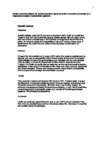Design recommendations for socially assistive robots for health and social care based on a large scale analysis of stakeholder positions
| dc.contributor.author | Bradwell, Hannah | |
| dc.contributor.author | Aguiar Noury, GE | |
| dc.contributor.author | Edwards, KJ | |
| dc.contributor.author | Winnington, R | |
| dc.contributor.author | Thill, S | |
| dc.contributor.author | Jones, Ray | |
| dc.date.accessioned | 2022-02-08T16:57:21Z | |
| dc.date.available | 2022-02-08T16:57:21Z | |
| dc.date.issued | 2021-09 | |
| dc.identifier.issn | 2211-8837 | |
| dc.identifier.issn | 2211-8845 | |
| dc.identifier.other | 100544 | |
| dc.identifier.uri | http://hdl.handle.net/10026.1/18719 | |
| dc.description.abstract |
Objectives: Socially assistive robots (SAR) may have an important role in health and social care. Design of such SAR can be informed through detailed studies with end-users, but we also need shared understanding of SAR between developers and those influencing policy. We aimed to explore the acceptability of using SAR across a broad range of stakeholders who could influence policy and identify design considerations for developers. Methods: We gave live demonstrations of a range of SAR rather than passive materials such as pictures, and used an acceptability model (Almere Model) as framework for analysis. Eight exhibitions involved live demonstrations and interaction with two robot animals (Paro and Miro), a humanoid (Pepper) and function-oriented telepresence robot (Padbot). 223 health and social care professionals, service users and small companies participated. Unstructured free interactions with robots were video recorded, transcribed, and content analysed. Themes were mapped onto the Almere Model of acceptability where components and design recommendations were deduced. Results: Three-quarters of attendees interacted with robots (n=167). Practical design changes identified were: (i) improved mobility for uneven floors and carpets, (ii) improved voice recognition and accent interpretation, (iii) better ease of use (mainly Pepper), (iv) enhanced robustness and battery life/autonomous charging, (v) soft, friendly aesthetics, (vi) anthropomorphic or biomorphic design (non-robotic) for friendliness and social presence, (vii) androgynous appearance. Conclusion: Health and social care stakeholders are open to use of SAR and see potential in this field, however, practical issues such as robustness, battery life, voice/accent recognition and mobility need to be addressed. Public Interest Summary: Robots that interact with people in health and care settings may have an important role in improving wellbeing. Detailed studies with end-users should inform SAR design for specific settings, however policy makers and robot developers must also share understanding of suitable design, for robots to be developed appropriate for health and care contexts. We gave live demonstrations of two robot animals (Paro and Miro), a humanoid (Pepper) and telepresence robot (Padbot) at eight events with 223 health and social care professionals, service users and small companies. Interactions with the robots were video recorded and used to assess their acceptability. Participants saw potential for robot use but identified practical concerns. These were: (i) improved mobility for uneven floors and carpets, (ii) improved voice recognition and accent interpretation, (iii) better ease of use (mainly Pepper), (iv) enhanced robustness and battery life/autonomous charging, (v) soft, friendly aesthetics, (vi) anthropomorphic or biomorphic design (non-robotic) for friendliness and social presence, (vii) androgynous appearance. | |
| dc.format.extent | 100544-100544 | |
| dc.language | en | |
| dc.language.iso | en | |
| dc.publisher | Elsevier BV | |
| dc.subject | Social robots | |
| dc.subject | Companion robots | |
| dc.subject | Acceptability | |
| dc.subject | Healthcare | |
| dc.subject | Social care | |
| dc.subject | Technology acceptance | |
| dc.title | Design recommendations for socially assistive robots for health and social care based on a large scale analysis of stakeholder positions | |
| dc.type | journal-article | |
| dc.type | Journal Article | |
| plymouth.author-url | https://www.webofscience.com/api/gateway?GWVersion=2&SrcApp=PARTNER_APP&SrcAuth=LinksAMR&KeyUT=WOS:000696997100006&DestLinkType=FullRecord&DestApp=ALL_WOS&UsrCustomerID=11bb513d99f797142bcfeffcc58ea008 | |
| plymouth.issue | 3 | |
| plymouth.volume | 10 | |
| plymouth.publication-status | Published | |
| plymouth.journal | Health Policy and Technology | |
| dc.identifier.doi | 10.1016/j.hlpt.2021.100544 | |
| plymouth.organisational-group | /Plymouth | |
| plymouth.organisational-group | /Plymouth/Faculty of Health | |
| plymouth.organisational-group | /Plymouth/Faculty of Health/School of Nursing and Midwifery | |
| plymouth.organisational-group | /Plymouth/REF 2021 Researchers by UoA | |
| plymouth.organisational-group | /Plymouth/REF 2021 Researchers by UoA/UoA03 Allied Health Professions, Dentistry, Nursing and Pharmacy | |
| plymouth.organisational-group | /Plymouth/Research Groups | |
| plymouth.organisational-group | /Plymouth/Research Groups/Institute of Health and Community | |
| plymouth.organisational-group | /Plymouth/Users by role | |
| plymouth.organisational-group | /Plymouth/Users by role/Academics | |
| dcterms.dateAccepted | 2021-06-15 | |
| dc.rights.embargodate | 2022-7-2 | |
| dc.identifier.eissn | 2211-8845 | |
| rioxxterms.versionofrecord | 10.1016/j.hlpt.2021.100544 | |
| rioxxterms.licenseref.uri | http://www.rioxx.net/licenses/all-rights-reserved | |
| rioxxterms.licenseref.startdate | 2021-09 | |
| rioxxterms.type | Journal Article/Review |


